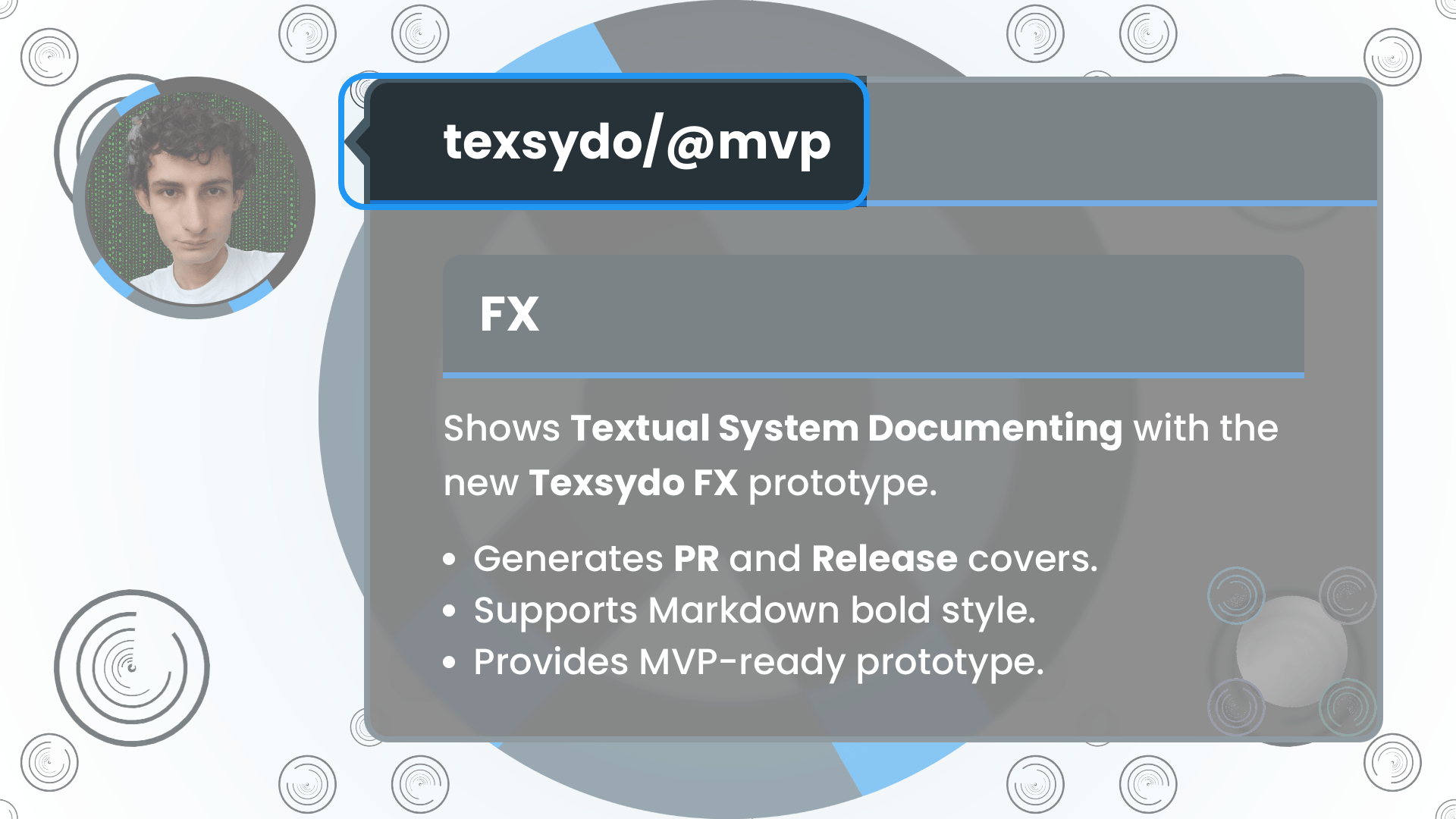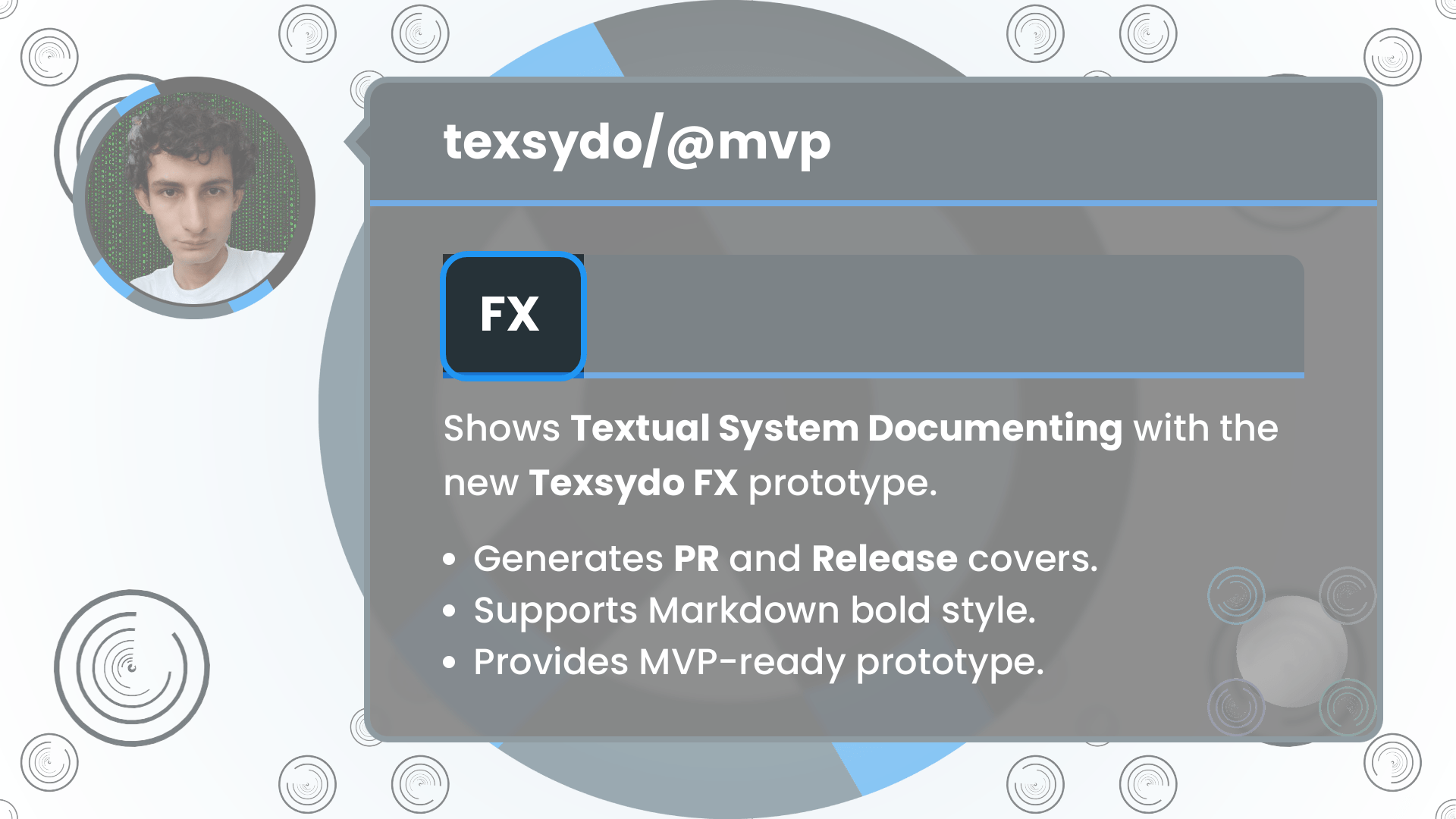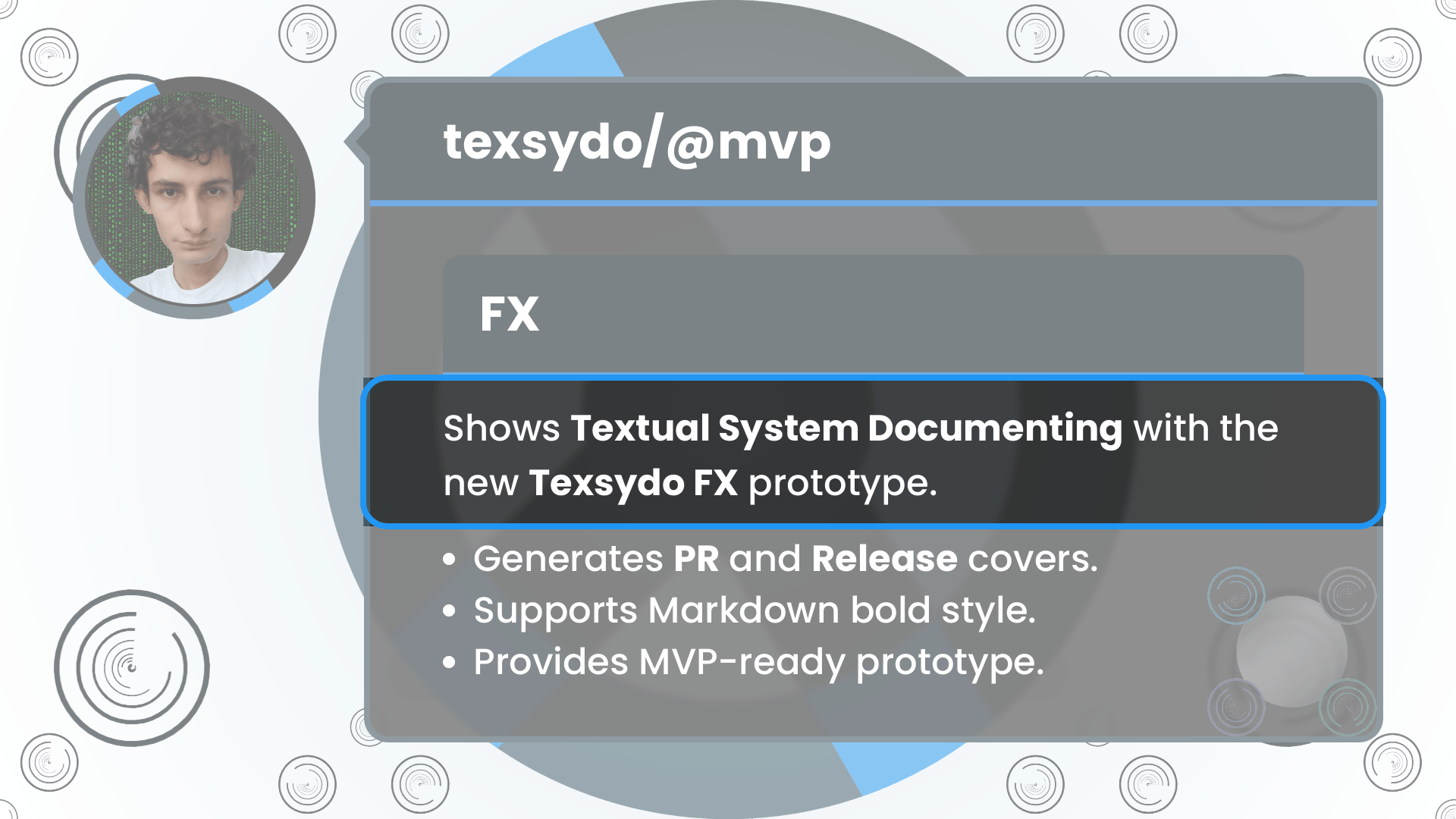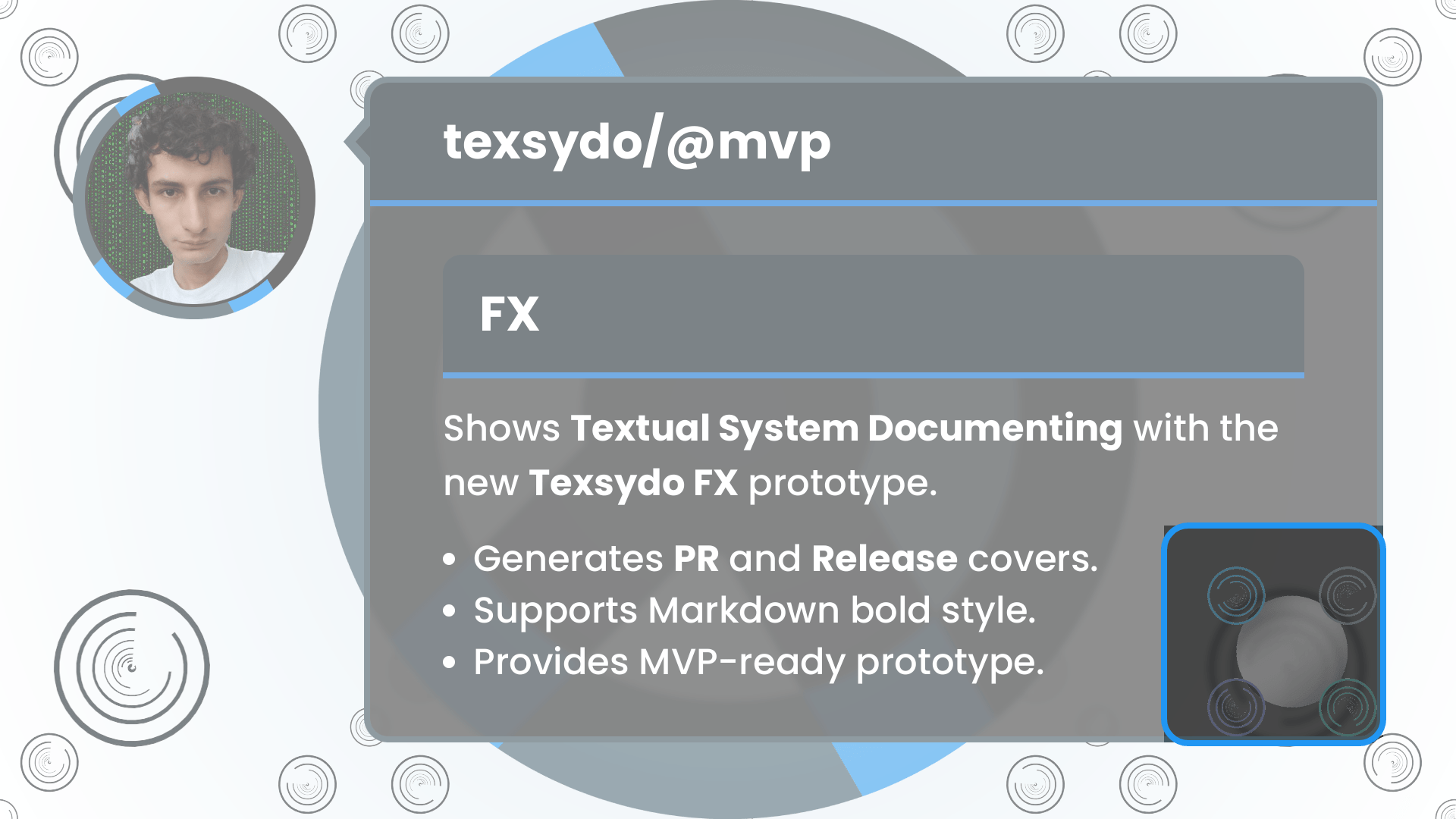Textual System Documenting
Text
Mathematical Documentation
Complex domains like mathematics, functional programming (FP), and engineering demand clear communication but are frequently challenging to present, leading to a loss of funding, support, or engagement. Texsydo aims to comply with MathSwe efficiency standards for formal and productive communication by expanding FP to documentation domains.
Texsydo is an Applied MSW aiming for modern mathematical text. Textual systems can encompass traditional articles or specific domains. Text is the source code that specifies an article of formal documentation.
Texsydo renders text into mathematical art for effectful domains, like a fractal from its recursive definition, model visualization, or development workflow.
Texsydo engineers articles under a functional approach, where the abstraction unit is the article, just as the function is in FP. Therefore, everything is an article in Texsydo. Formalities and systematized articles optimize inference to enhance mathematical and engineering documentation.
Engineering functional programming into mathematical writing simplifies articulating rigorous concepts that become into art. While mathematical text specifies concepts, art represents them, ensuring clear communication for complex domains. Texsydo aims to provide mathematical text and art to optimize demanding communication from mathematics to engineering.
Web
Mathematical Text to Web Article
Web articles are modern, portable, easy to write, and deploy with minimal overhead or setup.
Web Ops
Texsydo Web Operations
Operations provide commands to create, build, and deploy mathematical articles in your domain-specific system.
⚠️ Texsydo Web is a challenging project, so its current MVP versions do not guarantee API stability for now. Texsydo Web tsd-web CLI is currently in the prototype stage without public availability until its ongoing migration to MVP finishes.
New Article
Creating Domain Aware Articles
tsd-web create { entry-id } { class_1, class_2, ..., class_n }- Entry ID is
automating-the-platform-operations-and-beyond-2023-08-31. - Classes are
mathswe, eng, automation, platform, ops.
.
├── mathswe
├── eng
├── automation
└── platform
└── ops
└── automating-the-platform-operations-and-beyond-2023-08-31
└── index.mdListing Articles
Repository Articles
tsd-web entriesBuilding an Article
Markdown to Static Site
tsd-web build { target } (jekyll)⚠️ Texsydo Web MVP will drop support for Jekyll later when it reaches a more mature stage.
- Target is the current branch
.. - The
jekyllflag builds intermediate code to a static site. - Run
tsd-web build . jekyll.
Serving an Article
Development Server
tsd-web serveDeploying an Article
GitHub Pages Deployment
tsd-web deploy { entry-id }Production Article
Automating the Platform Operations and Beyond (2023/08/31)It deploys the given article from the main branch to the gh-pages one.
Domain Dictionary
Smart Text Transformations
Declarative user dictionaries tell Texsydo the transformations from the low-level form of a word used as a syntax to the high-level word to render.
Dictionaries keep the system domain-specific and, therefore, well-informed and efficient by removing redundant work prone to errors and writer burnout.
Dictionary(
uppercase = setOf("bsd", "pr"),
composed = mapOf(
"mathswe" to listOf("math", "swe"),
"github" to listOf("git", "hub"),
),
acronym = mapOf(
"swam" to "Special Software and Models",
"ddo" to "Data-Driven Organizations",
),
custom = mapOf(
"intellij-idea" to "IntelliJ IDEA",
"leds" to "LEDs",
)
)Map of Words
bsdBSDprPRmathsweMathSwegithubGitHubswamSpecial Software and ModelsddoData-Driven Organizationsintellij-ideaIntelliJ IDEAledsLEDs
In-Article Projects
Example Project Associated with an Article
Technical articles can contain an associated project offering complete source code to readers, while standard articles can still provide files. Everything is first-class, with cohesive navigation without leaving the website.
In-article projects are Example Projects (EPs) since the article bounds them to that scope. The unique EP benefits can thus enhance the value a technical article provides.
If the article contains a web app project, Texsydo Web will also build and deploy it within the article.
📂 drawing-a-tree-on-canvas-with-xy-coordinates
├── index.md
├── 📂 mrm-solution-tree---ep
│ ├── other-project-files...
│ ├── package.json
│ ├── package-lock.json
│ ├── README.md
│ ├── 📂 src
│ │ ├── index.html
│ │ └── other-project-sources...
│ ├── tsconfig.json
│ └── webpack.config.js
└── other-article-files...tsd-web build drawing-a-tree-on-canvas-with-xy-coordinates jekyll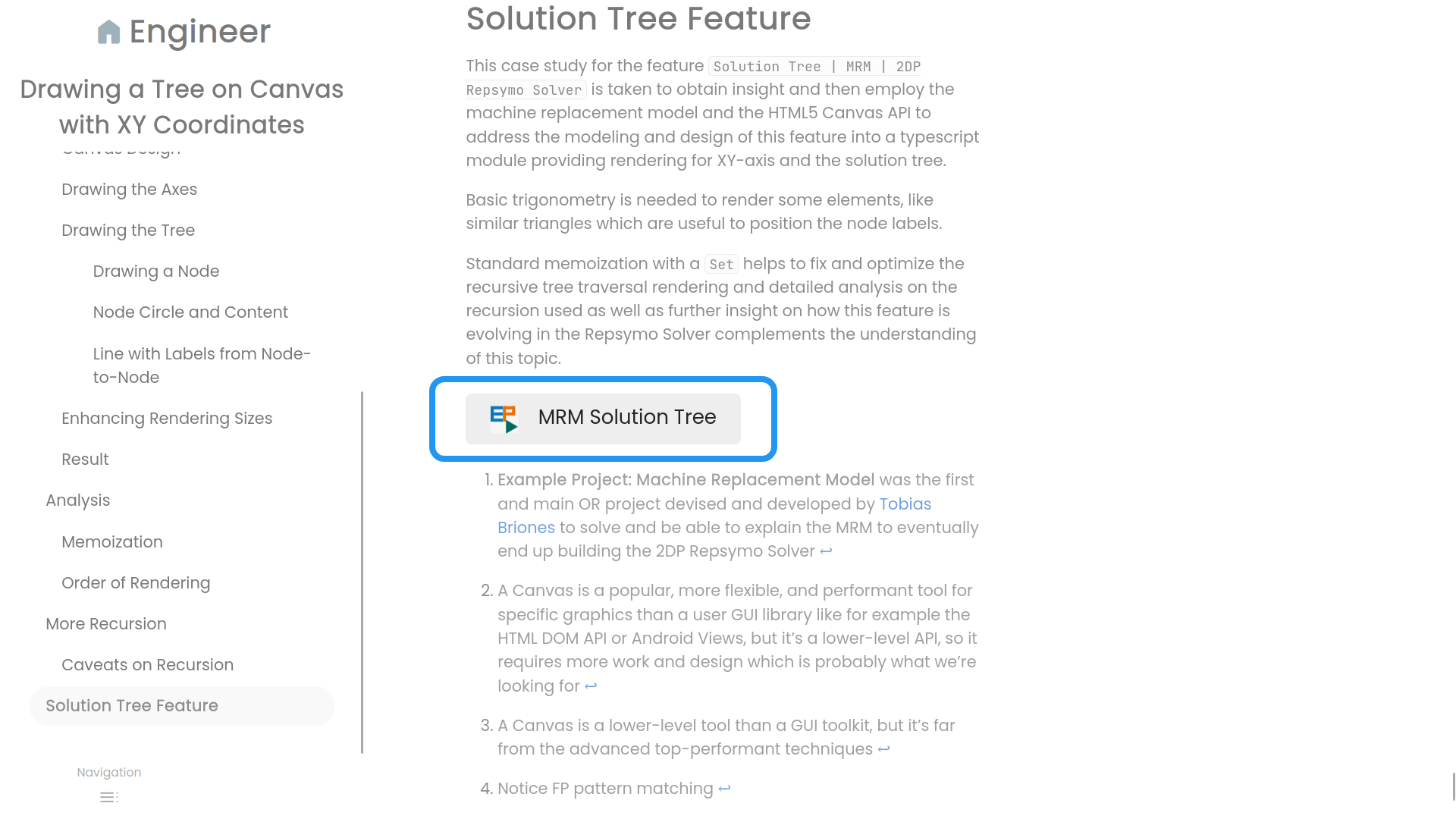
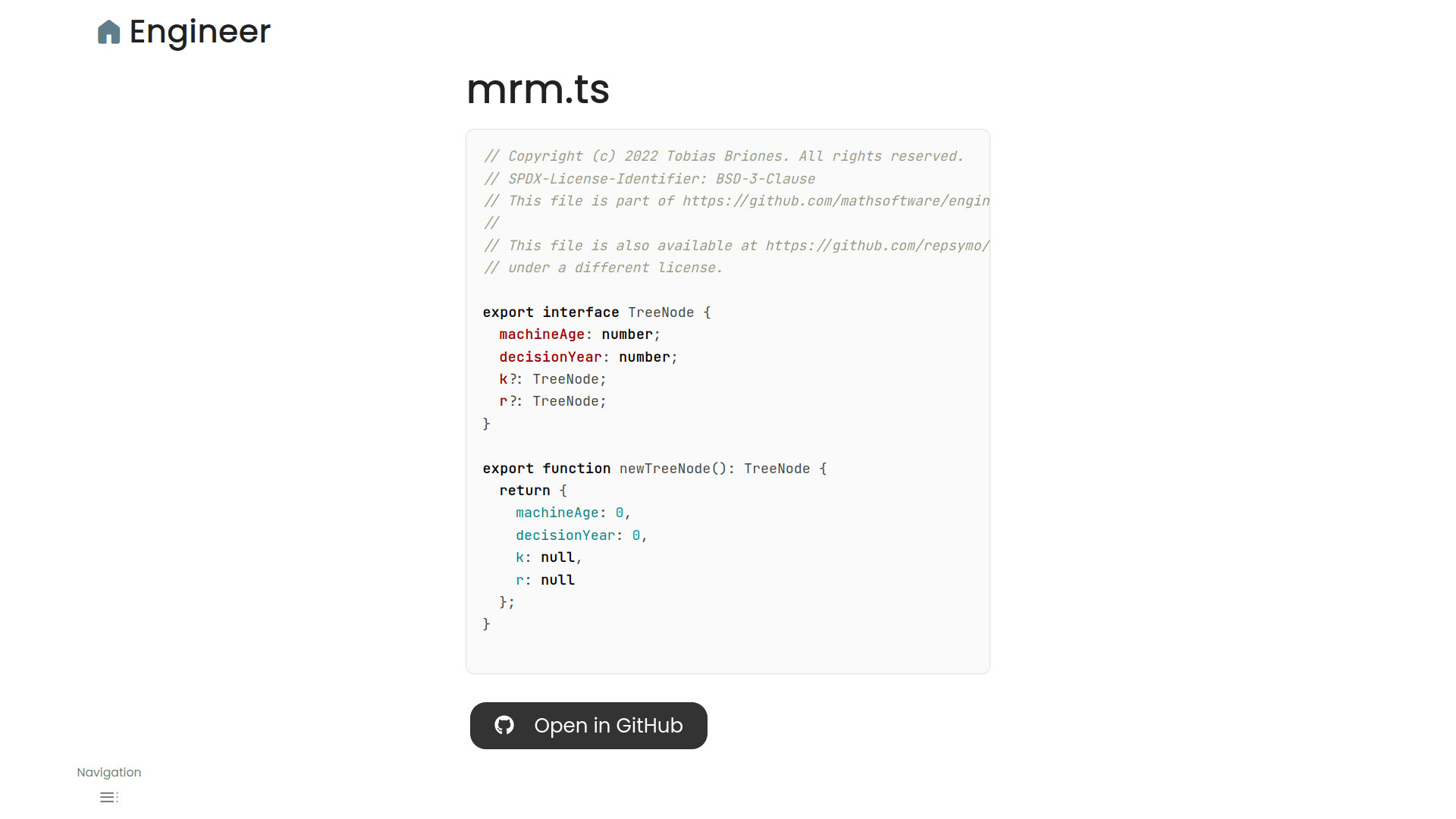
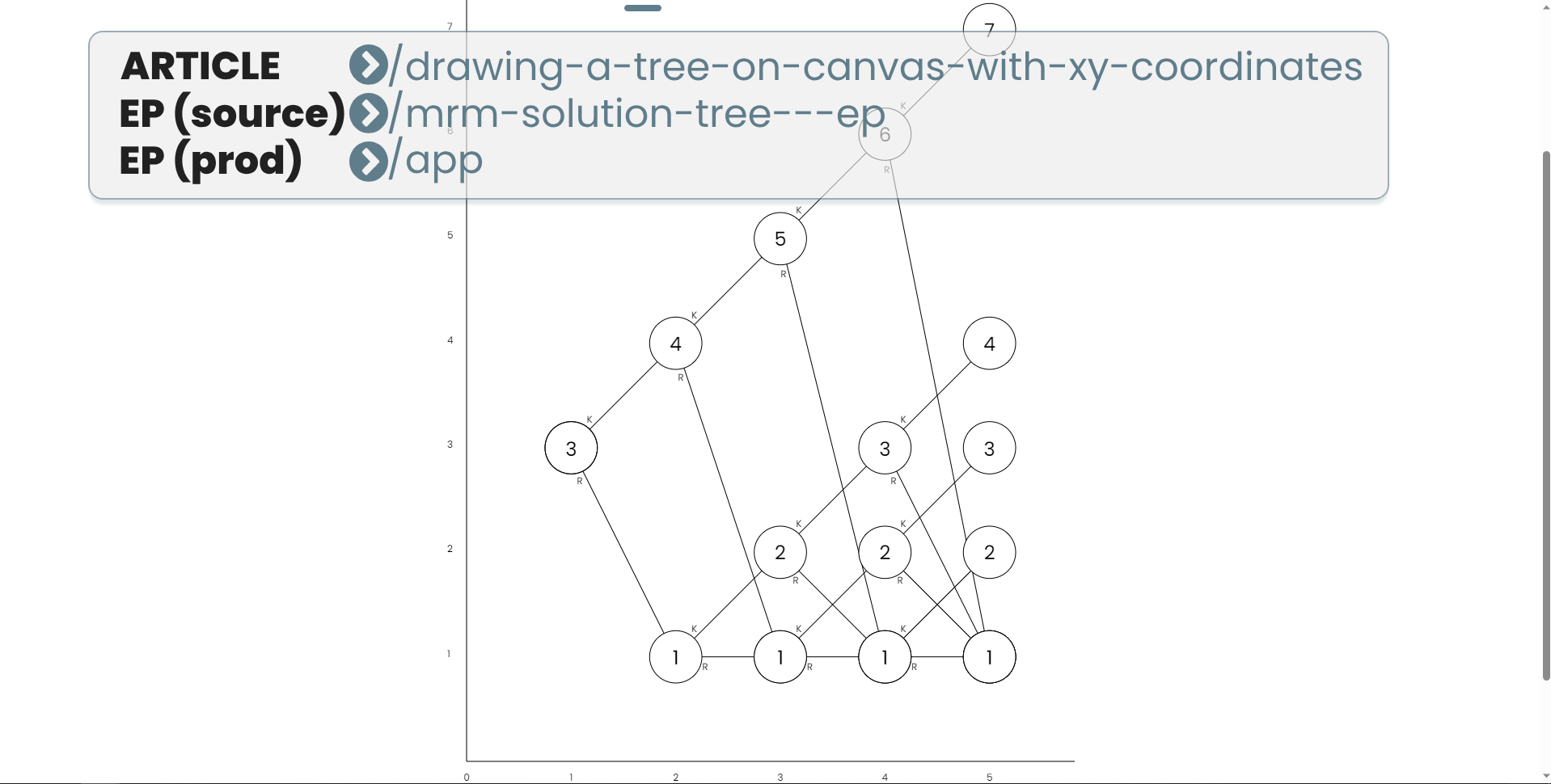
Drawing a Tree on Canvas with XY Coordinates
Advanced additions like associated files, example project source code, and web apps enhance articles by growing them cohesively. Texsydo Web allows articles to specify their DSL enabling completeness from the academic text to the engineering specification.
PR and Release Workflow
Clear and Complete Development Communication
Texsydo Web infers development workflow to automate updates of PR and Release blogs, currently only available for MathSwe projects.
tsd-web add-pr { entry-id } { class_1,class_2,...,class_n } { path } { from-pr }It uses the syntax of the create command plus path and from-pr arguments.
pathis the GitHub repository path, likeorg/repo.from-pris the first PR number to take (inclusive), and the program will fetch the rest of the PRs until the last one. This option doesn’t provide more flexibility yet.
tsd-web add-pr \
initializing-ops-with-a-cookie-banner---mathswe-com-2024-03-21 \
mathswe, legal, cookies, pr \
mathswe/legal \
1The pr class must be the direct parent directory of the article to enable inference, as shown above.
It creates the article in the mathswe/legal/cookies/pr directory. It adds the PRs from GitHub with proper styles. It requires developers to maintain balanced communication on GitHub to move forward continuously in a linear direction.
The remaining developer's job is to finish the article with the conclusion and abstract sections and add the cover textual file. Texsydo will build it into a PNG image according to MathSwe graphical standards.
A Markdown source file defines the cover image with the same name as the article and .png.md extension. It must contain a tiny abstract with an optional list. It supports bold style.
While support for PR articles is wider, current support for Release articles is limited to generating the cover image.
Texsydo Web enables efficient and thoroughly formal written communication from low-level technical details to high-level product engineering as per MathSwe standards.
FX
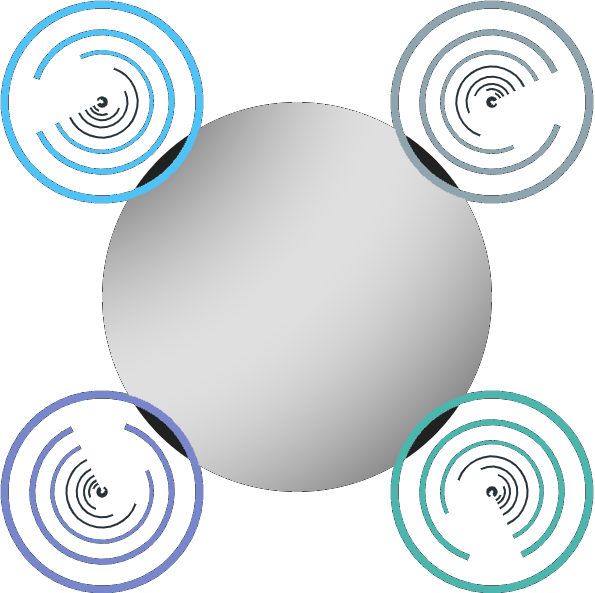
Text Effects
Texsydo renders text as mathematical art in effectful domains of article graphics.
Development Article Cover
Continuous Development with Documentation Assistance
Texsydo FX currently supports generating cover images for blogs that update on Pull Requests (PRs) and project releases in MathSwe.
⚠️ Texsydo FX tsd-fx CLI is currently in the prototype stage without public availability until its ongoing migration to MVP finishes.
tsd-fx pr-cover preview \
--profile-photo = profile.jpeg \
--heading = texsydo/@mvp \
--subheading = 'FX' \
--abstract = 'Shows **Textual System Documenting** with the new **Texsydo FX** prototype.' \
--details = 'Generates **PR** and **Release** covers.,Supports Markdown bold style.,Provides MVP-ready prototype.'"
--subdomain = texsydo-fx---mvp.png \
--bg-color = white \
--bg = msw-fractal.pngThe above command will show a preview window with the rendered image.
FX will save the image by removing the preview unnamed parameter and specifying an output argument with the destination path.
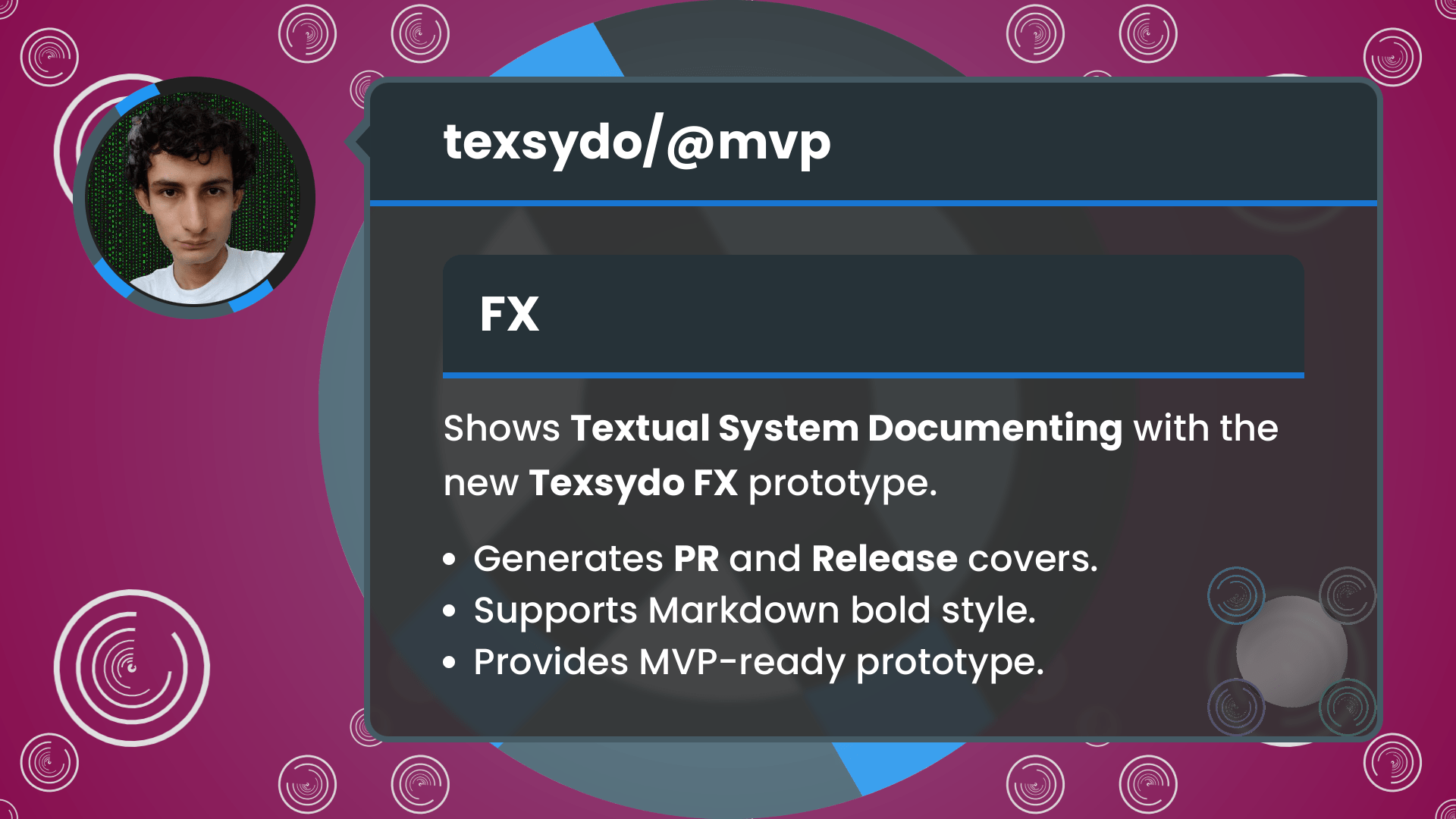
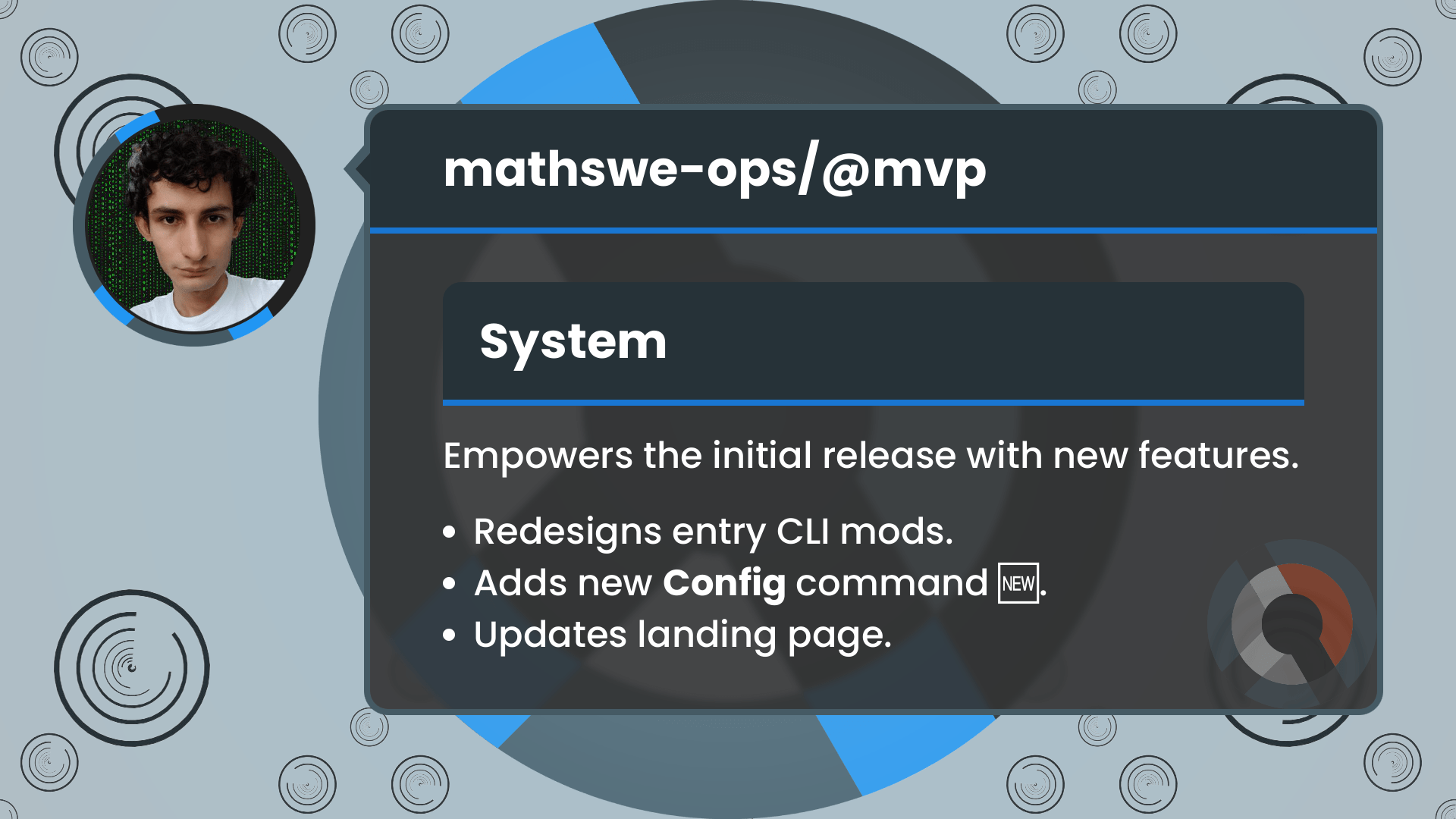
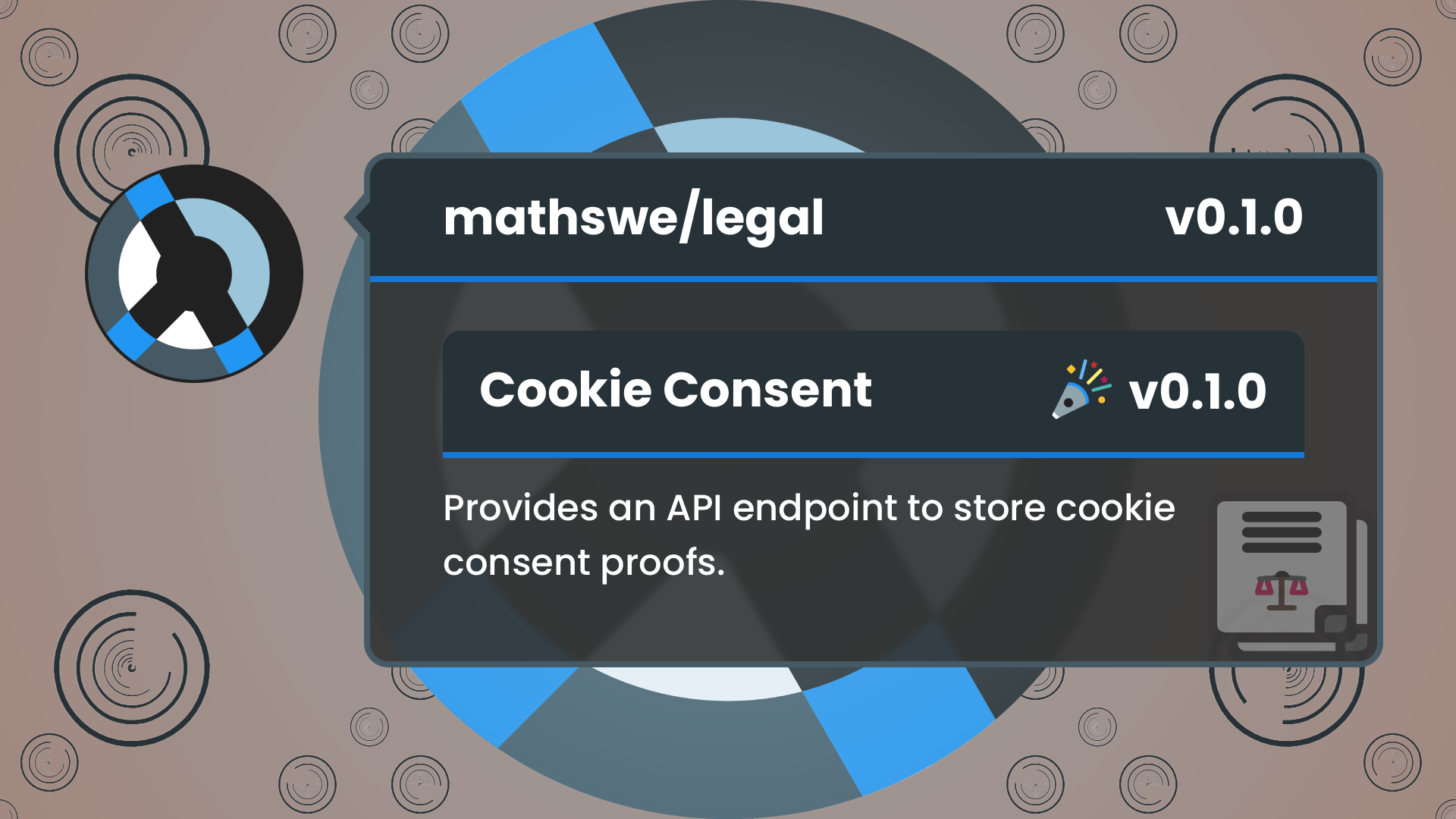
Release covers take the profile photo of the organization rather than the developer or team.
Further, they support versions for micro-projects besides the version of the whole repository. Standalone projects of a common repository, like microservices and MVPs, integrate smoothly with their independent version.
Texsydo Web, with domain specifications, infers development context from PRs and releases and calls FX to streamline article graphics under MathSwe standards.
Canvas Play
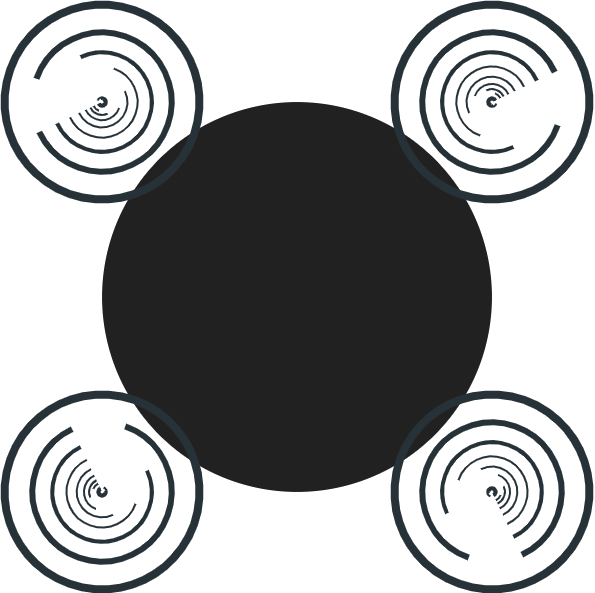
Innovating Incoming Visualizations
Texsydo FX has internal prototypes to design new graphical products beyond Texsydo to iterate results earlier.
Repsymo FX
Model Representation
Texsydo FX Prototype currently provides support to render model visualizations of Repsymo.
Repsymo is an Applied MSW that currently solves Operations Research (OR) models, while Texsydo FX Prototype powers their rendering.
TextThe initial machine age is three years, with a maximum operational lifespan of six years. A new machine costs $100,000.
Solution Space- X-axis is the
decisionYear. - Y-axis is the
machineAge.
Step-by-Step RenderingThe above animations are FHD 9:16 60FPS renderings, and the time per slide is also configurable.
The first visualization showcases the step-by-step general rendering order of the solutions tree, while the second offers a complete visualization of all the rendering steps and model solutions.
Texsydo FX can implement new graphical features quickly to pipe the text or mathematical output of another MSW, like Repsymo, and render it into formal visualizations.
Engineering Specs and Art
DSLs for Domain Experts
The Texsydo FX Prototype is currently experimenting with new graphics APIs based on evolving requirements.
APIs can provide a language to final users, allowing them to document specifications with domain tools like rulers, captions, etc. Further, it enables the creation of art from text using only mathematical definitions, like shapes and equations.
The above animations are 1800p 1:1 60FPS renderings.
The first animation represents a drawing with metrics, while the second builds an artistic drawing with shapes, both step-by-step.
Texsydo FX aims to provide DSLs for domain experts to create formal specifications and mathematical art while its prototypes allow quicker iterations to speed up innovation.

